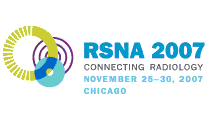
Abstract Archives of the RSNA, 2007
SSG19-06
Small Unsuspected Pulmonary Embolism Detected on Outpatient ECG-gated CTA for Chest Pain: Does Size Matter?
Scientific Papers
Presented on November 27, 2007
Presented as part of SSG19: ISP: Cardiac (CT)
Michael Kemal Atalay MD, PhD, Presenter: Speaker, General Electric Company
Shawn Hajimomenian MD, Abstract Co-Author: Nothing to Disclose
John Albert Pezzullo MD, Abstract Co-Author: Nothing to Disclose
David J. Grand MD, Abstract Co-Author: Nothing to Disclose
William W. Mayo-Smith MD, Abstract Co-Author: Research support, General Electric Company
Research support, Bracco Group
John Joseph Cronan MD, Abstract Co-Author: Nothing to Disclose
The advent of high-resolution 64-slice ECG-gated CT angiography (CTA) provides clarity and detail of small pulmonary vessels not previously available. The aim of this study was to determine the prevalence, detection confidence, and significance of small PE on ECG-gated CTA performed for outpatient assessment of chest pain.
A retrospective review was conducted on 64 consecutive ECG-gated CTAs performed over a 2-month period. All studies were conducted on a 64-detector row scanner using a contrast injection protocol designed to optimize opacification of all thoracic vessels (iodixanol 320; in order: 20cc timing bolus; 60cc @ 5.5cc/s; 50cc @ 4.5cc/s; 50cc saline @ 3.5 cc/s. FOV 30 cm; isotropic resolution 0.6 mm). All patients (32 women; age: 59±16 years) had been referred on an outpatient basis for evaluation of atypical chest pain. 59 studies (92%) were felt to be of diagnostic quality for PE detection to the subsegmental level and were included in the analysis. All studies were reviewed and the confidence level of each positive finding was made on a 5-point scale by two radiologists (1=no PE, 2=doubtful, 3=possible, 4=probable, 5=definite PE). Lower extremity ultrasound was performed in positive cases to exclude deep venous thrombosis.
Seven small, subsegmental, PEs were found in 4 patients (6.8%). All seven PEs were considered definite. All 4 patients were correctly identified on the initial evaluation. However, an additional small PE was found in 2 patients. Two patients were found subsequently to have clinically significant lower extremity deep venous thromboses. A third was known to have had remote PE. Anticoagulation was initiated in all 3.
High-resolution, 64-detector row ECG-gated CTA permits detection of very small PEs with very high confidence. These may go undetected on non-gated, lower-resolution studies. Data from this study suggest that when small PEs are detected, evaluation of the lower extremities for deep venous thrombosis should be performed.
High-resolution 64-detector row ECG-gated CTA performed for atypical chest pain may permit detection of unsuspected small, peripheral PEs. Further clinical and imaging work-up may be appropriate.
Atalay, M,
Hajimomenian, S,
Pezzullo, J,
Grand, D,
Mayo-Smith, W,
Cronan, J,
Small Unsuspected Pulmonary Embolism Detected on Outpatient ECG-gated CTA for Chest Pain: Does Size Matter?. Radiological Society of North America 2007 Scientific Assembly and Annual Meeting, November 25 - November 30, 2007 ,Chicago IL.
http://archive.rsna.org/2007/5005761.html

